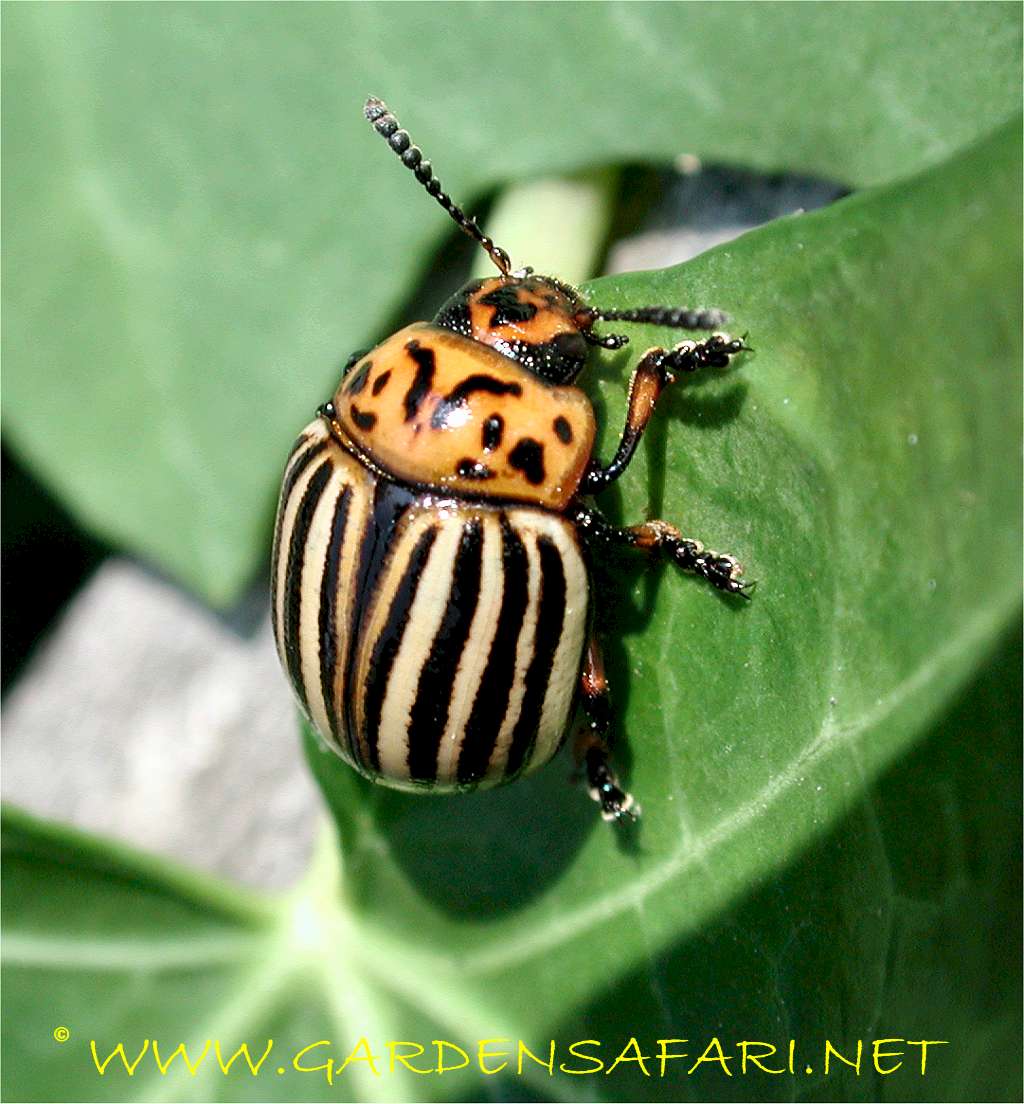Colorado
Potato Beetle
Scientific
Name: Leptinotarsa decemlineata
Order:
Coleoptra Family: Chrysomelidae
Life Stages: Complete metamorphosis (egg,
larvae, pupae, adult)
Eggs: Are
bright orange, foot-ball shaped and found in
clumps of 20-60 on the underside
of leaves. They hatch in 4-9 days.
Larvae: Are reddish, ½” long and humpbacked
with 2 rows of black spots down the sides. They are found mostly near the hatching
site or on the top of the potato plant. As they mature through the 4 molt
(instar) stages, they tend to move farther away in search of more food. This whole maturing process takes a mere 2-3
weeks.
Pupae: Found burrowed in the soil near
the potato plant, the pupae are oval and orangish in colour. The adult will
emerge in 5-10 days.
Adult: The adults are 3/8” long,
yellowish-orange robust and oval insects. They have 10 black stripes down their
elytra (leathery wings). Interestingly enough, the beetle overwinters as an
adult and their emergence is more or less synchronized with potato plants.
 Type of Damage: Both adults and larvae feed on their
host plants’ foliage and stems. Adults usually cause less severe damage, except
in cases where they eat through the stem of young host plants and cause the
plant’s subsequent death. One beetle will not cause much damage; however, their
high reproduction rates and subsequent unchecked eating often causes full
defoliation of the host plants.
Type of Damage: Both adults and larvae feed on their
host plants’ foliage and stems. Adults usually cause less severe damage, except
in cases where they eat through the stem of young host plants and cause the
plant’s subsequent death. One beetle will not cause much damage; however, their
high reproduction rates and subsequent unchecked eating often causes full
defoliation of the host plants.
Control Methods:
Cultural: There are three cultural control
methods that work quite well. 1. Crop rotation, with a 0.5 km protection
distance of susceptible crops, is known to have reduced the beetle populations
by 95.8%. 2. Delaying your planting
until later in the season or planting varieties that will produce earlier in
the season (before beetle damage is significant) are two other good options.
And 3. Plant a “trap” crop to seduce the insects and then destroy the trap
crop.
Physical: Digging small trenches around
your crop at a 45 degree angle can trap the beetles (they usually walk to crops
after spring emergence). Up to 95% of the beetles can remain trapped in these
trenches. If dealing with a small number of plants, hand-picking of adults and
eggs is also a viable option.
Biological: Many biological controls are not
effective because of the early onslaught of beetle damage, however, the
following creatures are predatory towards the Colorado potato beetle: A blue-green ground beetle (Lebia grandis), predatory stink bugs,
green lacewings, the spined soldier bug (Podisus
maculiventris) and a tachnid fly (Myiopharus
doryphorae).
Chemical: The beetle quickly grows immune
to pesticides, so most are not effective after a few years (i.e. Sevin). Also, only
applications to young larvae are effective as eggs and pupae are protected and
adults are very difficult to spray. The four chemicals still recommended,
however, are Rotenone, a botanical insecticide (recently registered for food
crops) produced upon extracts from the Neem tree, a fungus (Beauveria bassiana) and the natural
bacteria product, Bacillus thuringiensis,
var. tenebrionis.
Types of Plants Affected: Potato crops and other plants
in the Solanacae family such as
eggplant, ground cherry, tobacco, tomato, etc. Its first recorded host plant
was the buffalo-bur.
Additional Information:
1.
The
adult females can lay up to 500 eggs over a 4-5 week period.
2.
They
are able to fly up to several kilometres to find a new host plant if need be.

No comments:
Post a Comment